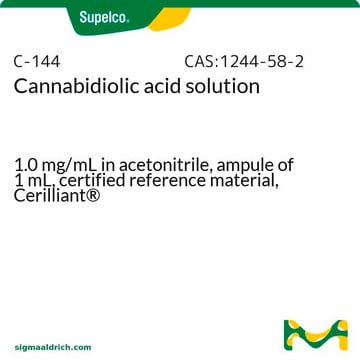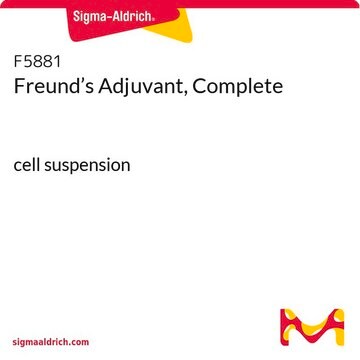Wichtige Dokumente
T-047
(±)-Δ9-THC -Lösung
100 μg/mL in heptane, ampule of 1 mL, Cerilliant®
About This Item
Empfohlene Produkte
Form
liquid
Leistungsmerkmale
Snap-N-Spike®/Snap-N-Shoot®
Verpackung
ampule of 1 mL
Hersteller/Markenname
Cerilliant®
drug control
Narcotic Licence Schedule D (Switzerland); psicótropo (Spain); Decreto Lei 15/93: Tabela IIB (Portugal)
Konzentration
100 μg/mL in heptane
Methode(n)
gas chromatography (GC): suitable
liquid chromatography (LC): suitable
Anwendung(en)
cannabis testing
cannabis testing
Format
single component solution
Lagertemp.
−20°C
SMILES String
O1C(C2C(c3c1cc(cc3O)CCCCC)C=C(CC2)C)(C)C
InChI
1S/C21H30O2/c1-5-6-7-8-15-12-18(22)20-16-11-14(2)9-10-17(16)21(3,4)23-19(20)13-15/h11-13,16-17,22H,5-10H2,1-4H3
InChIKey
CYQFCXCEBYINGO-UHFFFAOYSA-N
Allgemeine Beschreibung
Sonstige Hinweise
Rechtliche Hinweise
Ähnliches Produkt
Signalwort
Danger
H-Sätze
Gefahreneinstufungen
Aquatic Acute 1 - Aquatic Chronic 1 - Asp. Tox. 1 - Flam. Liq. 2 - Skin Irrit. 2 - STOT SE 3
Zielorgane
Central nervous system
Lagerklassenschlüssel
3 - Flammable liquids
WGK
WGK 2
Flammpunkt (°F)
24.8 °F - closed cup
Flammpunkt (°C)
-4 °C - closed cup
Hier finden Sie alle aktuellen Versionen:
Analysenzertifikate (COA)
It looks like we've run into a problem, but you can still download Certificates of Analysis from our Dokumente section.
Wenn Sie Hilfe benötigen, wenden Sie sich bitte an Kundensupport
Besitzen Sie dieses Produkt bereits?
In der Dokumentenbibliothek finden Sie die Dokumentation zu den Produkten, die Sie kürzlich erworben haben.
Active Filters
Unser Team von Wissenschaftlern verfügt über Erfahrung in allen Forschungsbereichen einschließlich Life Science, Materialwissenschaften, chemischer Synthese, Chromatographie, Analytik und vielen mehr..
Setzen Sie sich mit dem technischen Dienst in Verbindung.











